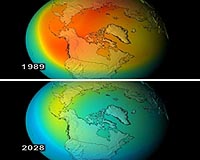| . |  |
. |
Berlin, Germany (SPX) Feb 28, 2011 German Aerospace Center researchers have been instrumental in the preparation of a report on the changes in the Ozone Layer for the World Meteorological Organization (WMO). The report was published online by the Geneva-based WMO in January. Recent estimates suggest that, by the middle of the 21st century, the thickness of Ozone Layer will be the same as in the early 1980s. "This positive development is due to the successful regulation of the production and use of substances containing fluoride, chlorine and bromine - for example, chlorofluorocarbons (CFCs) - through the Montreal Protocol of 1987 and subsequent international agreements," explained Martin Dameris from the DLR Institute of Atmospheric Physics. "This process has demonstrated the positive results that can come about when scientific findings lead to political action," said Dameris, adding, "This positive development can only be guaranteed if the agreements in the Montreal Protocol continue to be followed strictly." According to the WMO report, we can expect climate change to actually accelerate the restoration of the Ozone Layer. The hole in the Ozone Layer over Antarctica will have largely closed by mid-century. In some regions, there may even be instances of 'over-recovery': this means that once the CFCs have completely degraded, ozone concentrations will actually be higher than they were before the Ozone Hole first appeared in the early 1980s. All the predictions in the ozone report are based on computational models that simulate physical, dynamic and chemical processes in the atmosphere. Referred to as 'climate chemistry models', these were produced at the DLR Institute of Atmospheric Physics (Institut fur Physik der Atmosphare), among other places. The main focus was to study the influence of climate change on the chemistry of the atmosphere in general, and on the Ozone Layer in particular. To investigate the Ozone Layer, the DLR institute conducted long-term simulations, starting in the past (for example, in 1960) and extending into the distant future. The computational results for the past are compared against observation data to evaluate the quality of the models, among other things. Delivering reliable estimates relating to future developments, such as those that might affect the Ozone Layer, is only possible on the basis of thoroughly tested models. To gain an understanding of atmospheric processes, atmosphere researchers use data from the DLR Remote Sensing Technology Institute (Institut fur Methodik der Fernerkundung; IMF). Researchers at this Institute are heavily involved in supplying data products derived from satellite-supported measurements. To obtain the highest accuracy possible, these satellite data products are compared against other independent data. This process culminates in high-value, quality-tested data that scientists can work with. The World Meteorological Organization (WMO) is a specialised agency of the United Nations. It focusses on the state and behaviour of Earth's atmosphere; its interaction with the oceans, the resultant climate and the consequent distribution of water resources following that. Since the discovery of the hole in the Ozone Layer in 1985, every four years, the WMO publishes reports on the state of the Ozone Layer in the stratosphere - the second layer of Earth's atmosphere, located at an altitude of 10 to 50 kilometres. DLR researchers Veronika Eyring, Martin Dameris, Diego Loyola, Patrick Jockel, Robert Sausen and Ulrich Schumann were lead authors, collaborators or expert advisors during the production of the WMO report.
Share This Article With Planet Earth
Related Links DLR Institute of Atmospheric Physics Applied Remote Sensing Cluster The World Data Center for Remote Sensing of the Atmosphere GOME-2 - DLR Earth Observation Center All about the Ozone Layer
 Better Quality Assurance For Disposal CFCs And Other Ozone Depleting Substances
Better Quality Assurance For Disposal CFCs And Other Ozone Depleting SubstancesLuxemburg (SPX) Feb 21, 2011 Although the treatment of waste refrigeration equipment containing CFCs has been an integral part of the European waste management sector for more than twenty years, another major source of CFCs from waste products has been largely ignored. In the 1970s climatically harmful CFCs and other ozone depleting substances (ODSs) began to be used not only in refrigeration and cooling systems, but also a ... read more |
|
| The content herein, unless otherwise known to be public domain, are Copyright 1995-2010 - SpaceDaily. AFP and UPI Wire Stories are copyright Agence France-Presse and United Press International. ESA Portal Reports are copyright European Space Agency. All NASA sourced material is public domain. Additional copyrights may apply in whole or part to other bona fide parties. Advertising does not imply endorsement,agreement or approval of any opinions, statements or information provided by SpaceDaily on any Web page published or hosted by SpaceDaily. Privacy Statement |